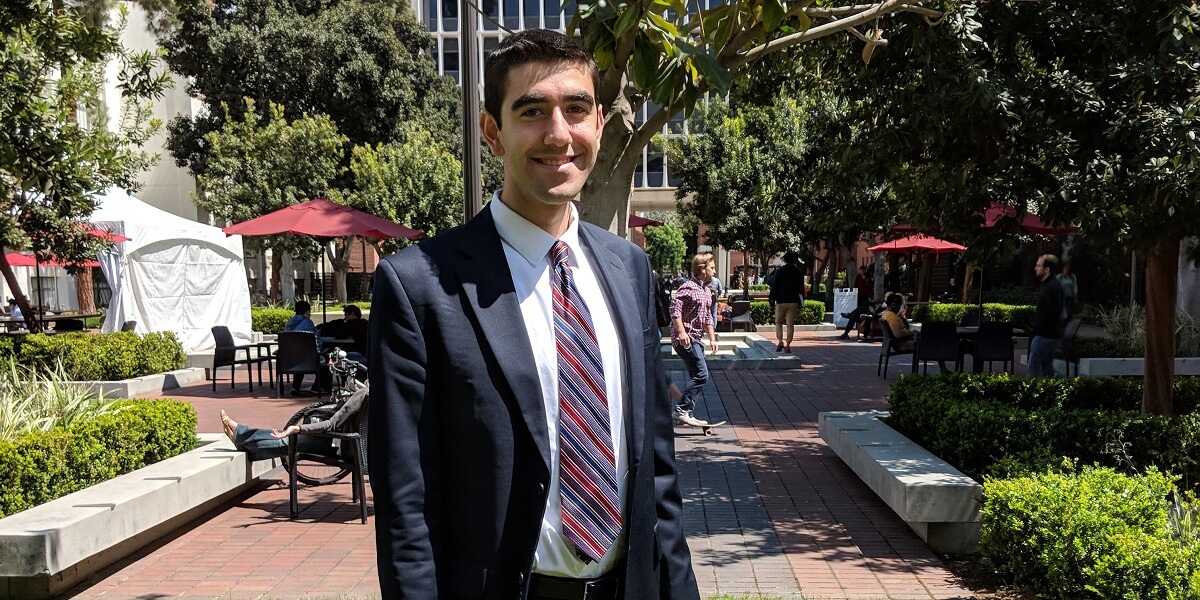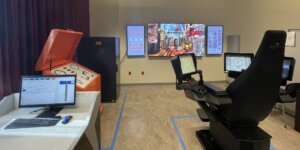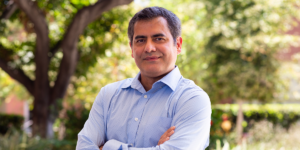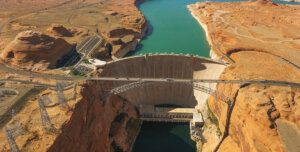
Saro Meguerdijian, a second-year PhD student in petroleum engineering, does research on coupling effects in subsurface reservoirs. Photo/Breanne Grady
For Saro Meguerdijian, boiling a pot of water is more than a step toward a college-aged feast of ramen noodles.
In fact, Meguerdijian sees a boiling pot as being like the “coupled flows” he studies as a second-year PhD student in USC Viterbi’s petroleum engineering (PTE) program. When heat from a flame causes water in the pot to turn into a gas (steam), the gas bubbles move up in the water, causing colder water at the top of the pot to move down. This link between the flow of heat and the flow of water is referred to as a “coupling.”
More specifically, Meguerdijian studies factors in the Earth’s subsurface that create coupling effects. The result can be mild or dangerous depending on the variables involved. An ill-timed mix of geomechanical factors beneath the ground can have terrible results – and even result in earthquakes.
“In the subsurface, we have water, gas, oil and steam, various things at various temperatures and at different depths,” Meguerdijian said. “All of these can produce couplings that affect how the ground behaves.”
Predicting earthquakes
But how can we predict if these couplings can cause something disastrous?
To solve that, Meguerdijian comes up with ways to evaluate thermoporomechanical (TPM) effects – heat, fluid flow and rock mechanics — in subsurface reservoirs. Combining data with physics, he can devise computational models to help predict potential human-caused earthquakes.
“Whether considering geothermal energy production, heavy oil recovery, carbon capture and storage, or offshore oil production, TPM effects can significantly change the economics, outcomes and safety of operations, especially when couplings are considered,” Meguerdijian said. “In the case of my research, I am interested in how these couplings can cause rocks to break and/or slip.”
By using mathematical models, Meguerdijian hopes to better estimate coupling effects. For his PhD research proposal, he was selected for a Department of Energy (DOE) Office of Science Graduate Student Research (SCGSR) award. This fall, he will be carrying out work for his dissertation at the DOE’s Lawrence Livermore National Laboratory (LLNL) in Livermore, Calif.
A professional in the making
For the SCGSR award, Meguerdijian was nominated by Assistant Professor Birendra Jha, his faculty adviser and an expert in coupled flows and geomechanics.
“Saro is very organized and focused, which helps him to understand the progression of research in his field based on existing literature, identify unsolved problems, and plan his own research methodology,” Jha said. “These are traits of a successful researcher.”
A very prepared and polished student, Meguerdijian credits PTE Program Director Iraj Ershaghi, the Omar B. Milligan Chair in Petroleum Engineering, for the program’s strong emphasis on professionalism and integrity.
“[Ershaghi] has a strong sense of the importance of the oil and gas industry to society, a pragmatic view of its challenges, and a deep sense of petroleum engineers’ collective responsibility to society,” Meguerdijian said. “It’s the sense that one petroleum engineer’s actions affect the success of all petroleum engineers.”
Meguerdijian, who also earned his bachelor’s degree in chemical engineering from USC Viterbi, also recognizes the positive influences other faculty members have had on him. “Dr. George V. Chilingar has been a great encouragement since I chose to pursue petroleum engineering,” Meguerdijian said. “I have also benefited from the thoughts of Dean Yortsos regarding the ethics of engineering as it relates to society. I appreciate the work of Professor Rich Roberts and other Mork Family Department of Chemical Engineering and Materials Science faculty in creating an environment where students can thrive.”
National Lab Connoisseur
Before his work this fall at LLNL, Meguerdijian will join a 10-week workshop at Los Alamos National Laboratory in Los Alamos, N.M. This time, he will be applying machine learning to develop models of brittle failure, which is the study of how things break. Brittle failure is significant in subsurface research because the way things break affects liquid flow properties.
“Being able to summarize the effects of cracks on the strength of rocks and the flow of fluid in a reservoir on a larger scale would greatly aid in making simulations more efficient, reducing the computing time needed,” Meguerdijian said.
With a pensive look, Meguerdijian expresses hope that his upcoming experiences will inform his future career plans. Currently, he is considering academia, national labs or the petroleum industry for a job.
Added Meguerdijian,“I currently prefer working at the intersection of academia and industry, but I want to work at a national lab before making my decision.”
Published on May 22nd, 2018
Last updated on July 10th, 2023











